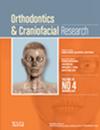The effects of unilateral increased occlusal vertical dimension (iOVD) on bilateral craniofacial, mandibular and alveolar development in growing rats were investigated via cone-beam computed tomography (CBCT). The role of Wnt/β-catenin signalling in this process was examined.
Forty-eight female Sprague–Dawley rats were randomly allocated into unilateral iOVD and sham groups. At 2, 4 and 8 weeks, the rats were scanned via CBCT to analyse cranial, maxillary, mandibular and dental morphology. Changes in temporomandibular joint (TMJ) cartilage histology and Wnt/β-catenin signalling were assessed by histochemical and immunohistochemical staining and qRT–PCR.
Dorsal cephalograms revealed that the mandible in the iOVD group tilted approximately 4° to the right. Unilateral iOVD had little effect on cranial and maxillary growth but inhibited mandibular growth (mandibular length and ramal height), especially on the deviated side (DS). Moreover, unilateral iOVD increased the length of the lower incisors and decreased the height of the molars on the DS. Unilateral iOVD induced bilateral osteoarthritis-like changes in the bilateral TMJ condylar cartilage and activated Wnt/β-catenin signalling in the condylar cartilage, especially on the contralateral side (CLS).
Occlusion with unilateral iOVD induced mandibular deviation, significantly inhibited mandibular growth and produced compensatory changes in the alveolar bone. In the iOVD group, the mandibular body length and ramal height were greater on the CLS than on the DS. Moreover, the greater β-catenin protein expression in the TMJ condylar cartilage on the CLS than on the DS may account for the difference in asymmetrical mandibular development.


